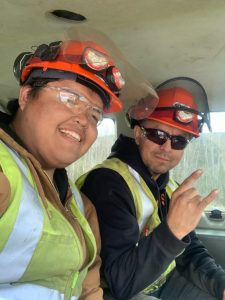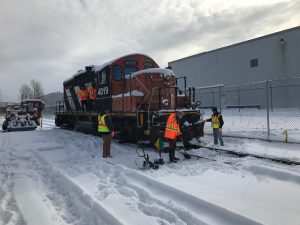
The impact of the railway industry on the Canadian economy can’t be downplayed. Over $320 billion worth of products are transported each year—and here in BC, those railways are increasingly being operated by Indigenous youth.
Rail companies in BC have been looking for ways to bring in new talent as large segments of their workforce reach retirement age, yet recruitment has always been a challenge in remote regions. At the same time, young people are seeking flexible, steady, high-paying positions that don’t require them to leave their communities.
It’s why, in 2018, BCIT revised its Railway and Rail Yard Employment Skills (RAIL 1001) program with the support of the Prince George Nechako Aboriginal Employment and Training Association (PGNAETA) and the Government of British Columbia. It’s been thriving ever since, and has graduated many successful cohorts over the past few years.
A program like no other
Steve Perry, Associate Dean, Motive Power at BCIT points out that high-quality rail programs are a rarity in Canada. “BCIT is very fortunate—we have our own dedicated and certified industrial railway, and we’re the only college in Canada that has one,” he says. “The Ministry of Transportation and Infrastructure has issued an operating certificate that we work under, so we are recognized as a certified industrial railway in the province of BC.”
BCIT has differentiated itself even more with its modular programs, which divide the typical training for a railway conductor into three distinct offerings. Each part-time course awards microcredentials, meaning students earn industry qualifications—and enter the workforce—even if they haven’t completed the entire program.
The first course in the program has been adapted so it can be brought directly to Indigenous communities. Streamlined, hands-on training is spread across four weeks, with the first and last delivered in-community. The two weeks in between take place at the BCIT railway facility in Delta. Indigenous learners can enroll in the program and apply for funding—tuition, travel, living expenses, personal equipment, and childcare may be paid for. Funding for support from elders may also be provided.
“This short program is aligned to the Railway Association of Canada outcomes,” says Steve. “That was very important to us—to have a course that would provide entry-level employment into railways.”
Integrated with industry

As with all BCIT offerings, one of the biggest advantages of the RAIL 1001 program is the direct involvement of industry leaders. “We have every major railway and railway supplier on our program advisory council supporting this program,” notes Steve. “Actually, our railway program advisory council chairperson was a senior executive with CN Rail for over 20 years.”
This level of input truly sets the program apart. “Our program delivery and development isn’t based on what we think should happen—it’s based on what industry feels they need.”
This engagement between BCIT and major employers extends beyond course development. CN Rail is a partner with the program, and provides students with access to everything from locomotive cars to corporate meeting rooms at some locations.
PGNAETA, another program sponsor, is playing an active role in connecting the right students with the right opportunities, and providing personal and professional support throughout the whole journey. The results are plain to see: “Most of our students have gained employment with large employers in BC—CN Rail is the most significant employer of those students, REMCAN is another one, PNR Rail is another one that has hired our graduates,” says Steve.
“We’ve achieved about a high employment rate for our Indigenous students, and they’ve also had some of the highest outcomes on the federal exams, because we follow the Rail Association of Canada examinations. They’ve been absolutely amazing.”
Innovative and resilient
Of course, a program that launched in 2018 could have easily been derailed by the pandemic in 2020. Thankfully, that didn’t happen, largely because the class had been technology-enabled since its inception. The Polytechnic Research Institution for Simulation and Multimedia at BCIT engaged instructors, designers, and railway experts to translate skills training into virtual reality (VR) experiences.
These interactive experiences enable students to explore environments that would otherwise be impossible to simulate in real life. For example, they can shrink themselves and walk through various mechanical components, they can connect an entire train, and they can even practice emergency measures at a crash site.
Originally, VR proved to be an effective way to bring experiential learning to remote and rural communities, but during the pandemic, it became a powerful tool to continue essential training while complying with provincial health and safety protocols. Students were still able to come to the school’s private railway facility for in-person learning, as physical distancing initiatives and smaller cohorts were put in place.
“We could maintain delivery of this course, even through the COVID-19 period—and all of those students have since been employed,” says Steve.
Have you subscribed? Sign-up to receive the latest news on BCIT.
Starting a virtuous cycle
Employment opportunities aren’t limited to the class 1 railways that span Canada. There are nearly 200 industrial railways and short lines throughout BC alone, many of which have recruited BCIT graduates. And the popularity of these programs is spreading among BC’s Indigenous youth. Graduates often recommend the railway course at BCIT to friends and family, who then enroll in the subsequent cohorts.
“This program model—including its industry connections—has resulted in so many employed students working and staying within their own community, and becoming invaluable employees of CN and REMCAN, who traditionally have difficulty filling positions in remote communities,” says Steve. “It’s a win-win from every angle you look at it.”
As the railway industry continues to drive BC’s economy, BCIT is proud to support Indigenous learners entering the industry. Speak to an advisor to learn more about this innovative program, or attend an info session.
(Note: Photos in this story were taken prior to the COVID-19 pandemic. Photo credit: PGNAETA)
